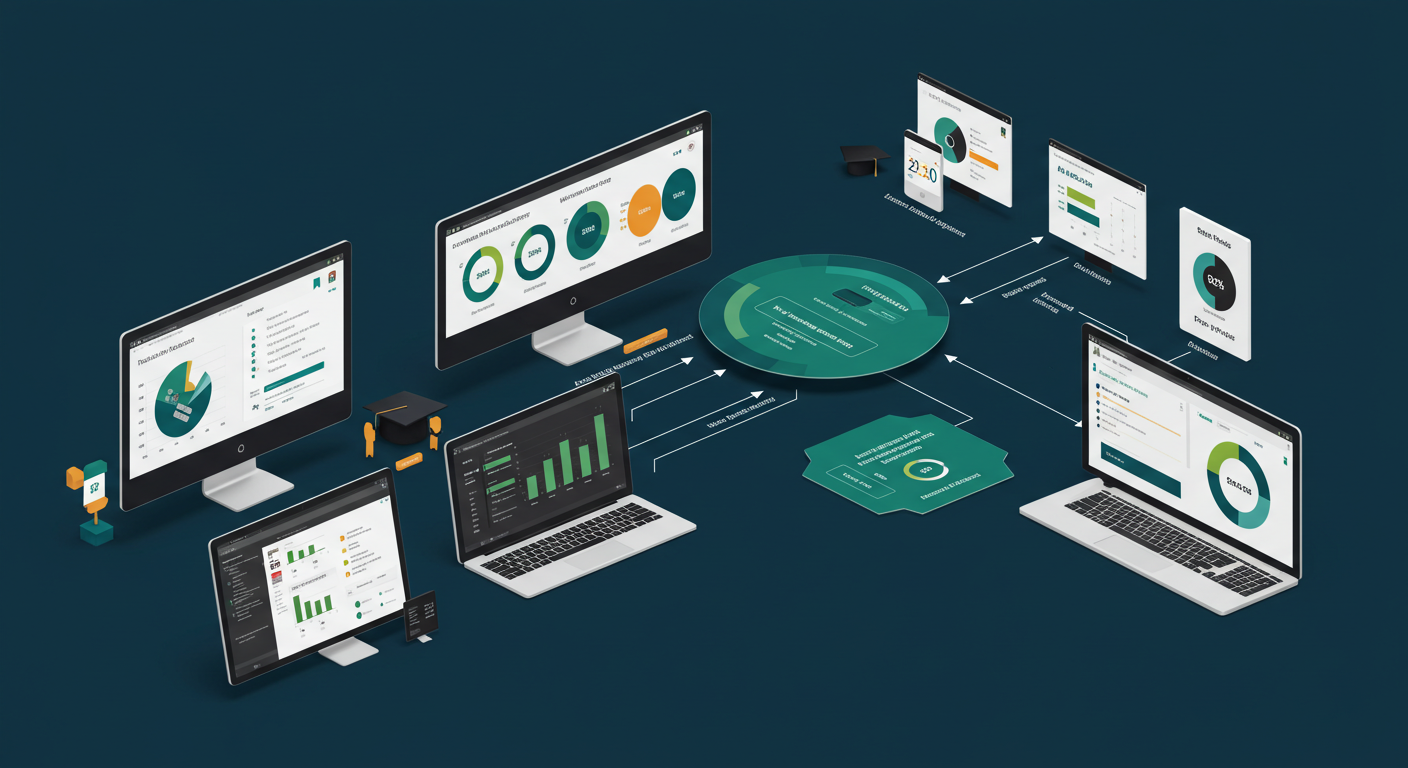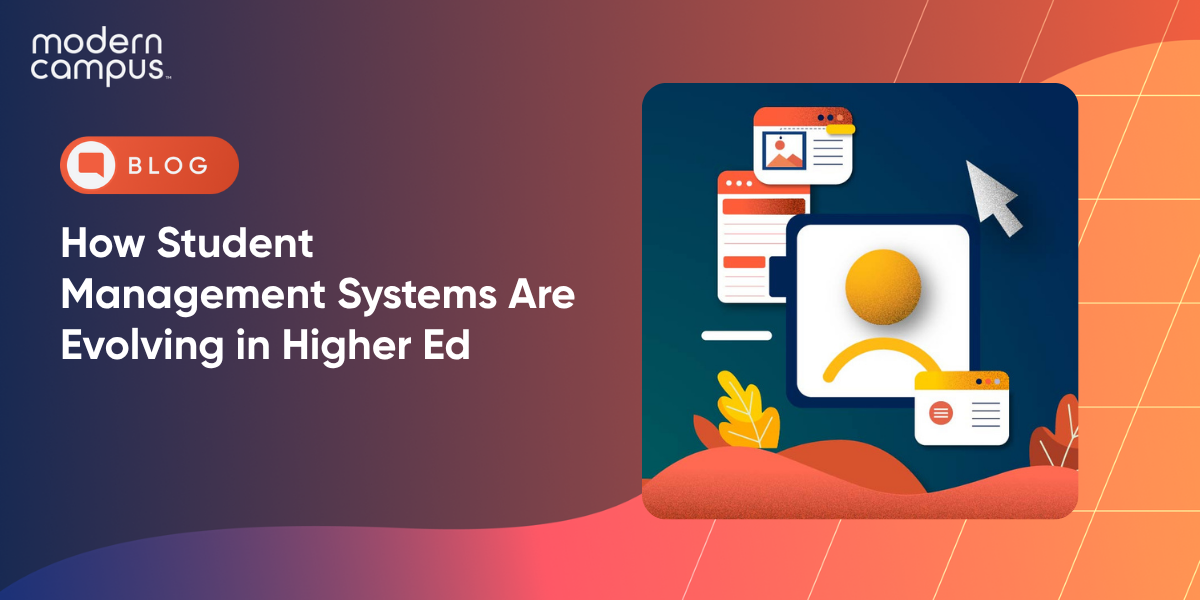How Student Management Systems Are Evolving in Higher Ed
The student information system market is experiencing explosive growth, with industry analysts projecting the sector will expand from approximately $15.33 billion in 2024 to over $32 billion by 2029, representing a 15.9% compound annual growth rate. This growth represents how higher education institutions manage, engage with and support their students throughout the entire academic lifecycle.
Today's student management systems look dramatically different from even five years ago. Old-school digital filing cabinets for student records have evolved into sophisticated platforms that leverage artificial intelligence, predictive analytics and seamless integrations to create more personalized, efficient and engaging educational experiences.
The transformation has been accelerated by changing student expectations, the need for data-driven decision making and the recognition that administrative efficiency directly impacts student success and institutional sustainability.
These evolutionary changes represent a broader digital transformation sweeping across higher education, where institutions are rethinking every aspect of the student experience. Understanding how these systems are evolving is crucial for institutional leaders who want to stay competitive, improve operational efficiency and better serve their students.
The Digital Transformation Journey: From Paper to Platforms
The evolution of student data management in higher education reads like a compressed history of the digital age itself. In the 1960s and 1970s, forward-thinking universities began experimenting with mainframe computers to automate basic administrative tasks, laying the groundwork for what would eventually become comprehensive student information systems. These early implementations were rudimentary by today's standards, often limited to simple data storage and retrieval functions that required specialized technical knowledge to operate.
The 1980s and 1990s marked a significant leap forward as institutions began adopting more integrated platforms capable of managing various administrative functions within unified frameworks. Universities started consolidating admissions, registration, financial aid and student records into single systems.
However, these solutions remained largely on-premises and required substantial IT infrastructure investments. The real breakthrough came in the early 2000s with the rise of internet-based platforms, which transformed student management systems from isolated institutional tools into accessible, collaborative platforms that students, faculty and staff could access from anywhere.
The COVID-19 pandemic served as an unexpected catalyst, compressing what might have been a decade-long digital transformation into mere months. Institutions that had been hesitant to embrace cloud-based solutions suddenly found themselves needing robust, scalable platforms that could support remote learning, virtual student services and distributed administrative operations.
According to recent industry data, approximately 70% of North American educational institutions have now adopted cloud-based student information systems, with adoption rates continuing to climb as institutions recognize the operational and financial benefits of these modern platforms.
Each technological advancement has made student management systems more accessible, integrated and focused on user experience. Early administrative convenience tools have evolved into comprehensive platforms that actively support student success, institutional effectiveness and strategic decision-making across all levels of higher education.
5 Major Ways Student Management Systems Are Evolving Today
1. AI-Powered Personalization and Predictive Analytics
Artificial intelligence is transforming student management systems from reactive data repositories into proactive engagement platforms. Modern AI-powered systems analyze vast datasets to identify patterns in student behavior, academic performance and engagement levels, enabling institutions to intervene early when students show signs of academic difficulty or disengagement. These predictive capabilities include factors like attendance patterns, library usage, dining hall visits and participation in campus activities.
The personalization capabilities of AI-enhanced student management systems are particularly impressive. These platforms can automatically generate individualized degree plans, recommend courses based on academic history and career goals and even suggest extracurricular activities that align with student interests and developmental needs.
Academic advisors now have access to comprehensive student profiles that include not just grades and credit hours, but insights into learning preferences, potential career paths and risk factors that might impact student success.

Implementation of AI features is becoming increasingly sophisticated, with some systems capable of generating automated communications that feel personal and relevant to each student's unique situation.
Rather than sending generic reminder emails about registration deadlines, these systems can craft messages that reference specific degree requirements, highlight relevant course options and provide personalized guidance based on the student's academic progress and declared interests. Understanding how to effectively use student data maximizes these personalization capabilities.
2. Cloud-First Architecture and Mobile Accessibility
Cloud-based student management systems reimagine delivering value to institutions and students. Cloud-first architectures provide the scalability and flexibility that modern higher education demands, allowing institutions to rapidly adjust system capacity based on enrollment fluctuations, peak usage periods and evolving functional requirements. Scalability is particularly valuable for institutions experiencing growth or those managing seasonal variations in system usage.
Mobile accessibility has become a non-negotiable feature rather than a nice-to-have addition. Students expect to access their academic information, register for courses and communicate with institutional services through their smartphones and tablets. Modern student management systems are designed with mobile-first principles, including everything from course registration and grade checking to financial aid management and campus event participation.
The cloud infrastructure also enables more sophisticated integration capabilities, allowing academic management software to connect seamlessly with learning management systems, financial aid platforms, library systems and third-party applications that students use for academic and social purposes. This interconnected ecosystem creates a more cohesive user experience while providing institutions with comprehensive data about student engagement and success factors across all touchpoints.
3. Advanced Data Integration and Interoperability
Modern platforms are designed to function as central hubs that aggregate information from multiple sources, creating comprehensive views of student experiences that transcend traditional academic records. This includes integration with learning management systems, student engagement platforms, financial systems and external tools for career development and networking.
The technical standards supporting this integration have significantly matured, with protocols like OneRoster and SIF 2.0 facilitating seamless data exchange between different educational technology platforms. These standards ensure that information flows automatically between systems, reducing manual data entry errors and providing real-time updates across all connected platforms.
Institutional administrators have access to current, accurate information that supports both day-to-day operations and strategic planning initiatives. The growing emphasis on educational technology integration reflects broader trends toward digital transformation in higher education.

Advanced analytics capabilities built into these integrated systems enable institutions to identify correlations and trends that were previously invisible. For example, institutions can now analyze relationships between students' library usage patterns, participation in campus activities, course performance and retention rates to identify the factors that most strongly predict student success.
This level of insight supports more targeted interventions and more effective allocation of support resources. Modern platforms also excel at improving student engagement through data-driven approaches that identify at-risk students before problems become critical.
4. Enhanced Security and Compliance Features
As student management systems become more comprehensive and interconnected, security and compliance considerations have become fundamental design principles. Modern platforms incorporate enterprise-grade security features, including multi-factor authentication, role-based access controls and advanced encryption protocols that protect sensitive student information both in transit and at rest. These security measures are transparent to users while providing robust protection against sophisticated cyber threats.
Compliance with regulations like FERPA, GDPR and state-specific privacy laws is built into the architecture of contemporary student management systems rather than being addressed through add-on features or manual processes.
These platforms automatically track access to student information, maintain detailed audit trails and provide granular controls over what information can be shared with whom and under what
circumstances. Administrators benefit from reduced compliance risk and simplified reporting for regulatory requirements.
Data backup and disaster recovery capabilities have also become more sophisticated, with cloud-based systems offering multiple layers of redundancy and automated backup processes that ensure student information is protected against technical failures and security incidents. Many platforms now offer near-instantaneous recovery capabilities, minimizing disruption to institutional operations.
5. Student-Centric User Experience Design
Rather than prioritizing administrative convenience, modern platforms are designed from the student perspective, focusing on intuitive navigation, personalized dashboards and streamlined workflows that reduce friction in common tasks like course registration, degree planning and academic resource access.
Contemporary student management systems feature customizable dashboards that allow students to configure interfaces based on their individual priorities and preferences. Students can choose to highlight upcoming deadlines, track progress toward degree completion, monitor financial aid status or access frequently used resources from a personalized homepage. This level of customization extends to communication preferences, notification settings and visual themes that make the platform feel more personal and engaging.
The user experience improvements include workflow optimization that reduces the number of steps required for common tasks. Modern platforms use progressive disclosure techniques to present complex information in digestible chunks, guided workflows that help students navigate complicated processes like degree planning or financial aid applications and intelligent defaults that reduce the cognitive load associated with system configuration and daily usage.
What These Changes Mean for Higher Education Institutions
These enhanced student management platforms are enabling unprecedented levels of operational efficiency by automating routine administrative tasks, reducing manual data entry errors and streamlining workflows that previously required coordination across multiple departments. Registrars report significant time savings in course scheduling and enrollment management, while financial aid offices can process applications more quickly and accurately thanks to integrated data and automated verification processes.
The impact on student engagement and retention is equally significant. Modern student management systems provide institutions with early warning indicators that help identify students who may be at risk of academic difficulty or departure before problems become critical. By analyzing patterns in course performance, attendance and campus engagement, these systems enable proactive interventions that can dramatically improve student success rates.
Institutions using advanced analytics features report measurable improvements in retention rates and time-to-graduation metrics. Comprehensive enrollment management strategies leverage these capabilities to support students throughout their entire academic journey.
Data-driven decision making has become more accessible and actionable thanks to sophisticated reporting and analytics capabilities. Institutional leaders can now access real-time dashboards that provide insights into enrollment trends, resource utilization, student satisfaction metrics and financial performance indicators. This level of visibility supports more informed strategic planning and enables institutions to respond more quickly to changing market conditions or emerging student needs.
The financial implications of these technological advances are substantial but complex. While modern student management systems often require significant upfront investments, they typically deliver strong returns through operational efficiencies, improved student retention and enhanced institutional effectiveness. Cloud-based platforms, in particular, can reduce IT infrastructure costs while providing access to enterprise-grade capabilities that would be prohibitively expensive for most institutions to develop and maintain independently.
Implementation Considerations for Modern Student Management Systems
Successfully implementing a student management system requires change management, staff training and strategic alignment with institutional goals. The most successful implementations begin with comprehensive needs assessments that identify specific institutional challenges, workflow inefficiencies and desired outcomes.
This strategic approach ensures that technology investments align with institutional priorities and deliver measurable value to students, faculty and staff. Following proven SIS implementation best practices can improve the likelihood of successful deployment and user adoption.

Modern academic management software must connect seamlessly with existing institutional technology infrastructure. Successful integration requires detailed mapping of data flows, identification of potential compatibility issues and development of protocols for maintaining data consistency across all connected systems. Institutions should prioritize vendors that offer robust integration capabilities and proven track records with similar institutional environments.
Change management considerations are equally important, as even the most sophisticated technology platform will fail to deliver expected benefits if users don't adopt new workflows and capabilities effectively. This includes comprehensive training programs for administrative staff, clear communication about system benefits and expectations and ongoing support resources that help users optimize their interactions with the new platform.
The most successful implementations involve users in system configuration and customization decisions, ensuring that new workflows align with actual institutional practices and user preferences. For institutions focused on non-traditional learners, selecting the right SIS platform can support diverse student populations and flexible learning models.
Looking Ahead: The Future of Student Management Systems
The trajectory of student management evolution suggests even more transformative changes on the horizon, driven by emerging technologies that promise to further enhance institutional effectiveness and student experiences.
Blockchain technology is beginning to show practical applications in credential verification and academic record security, potentially revolutionizing how institutions manage transcripts, certificates and other official documents. Early implementations suggest that blockchain-based credentialing could reduce verification processing times while providing students with more portable and verifiable academic records.
Internet of Things (IoT) integration represents potential applications ranging from automated attendance tracking to campus safety monitoring and resource utilization optimization. Smart campus initiatives are already demonstrating how IoT sensors can provide real-time data about facility usage, environmental conditions and student movement patterns that can inform both operational decisions and academic support strategies. As these technologies mature, they're likely to become integrated features of comprehensive student management platforms.
Advanced artificial intelligence capabilities will include more sophisticated natural language processing, automated content generation and intelligent workflow optimization. Future student management systems may be able to automatically generate personalized learning recommendations, create customized degree plans that adapt in real time based on academic performance and career market changes and provide intelligent virtual assistant capabilities that can handle routine student inquiries without human intervention. According to educational technology forecasts, AI-powered systems will become increasingly central to institutional operations and student support services.
The integration of virtual and augmented reality technologies also holds promise for enhancing student engagement and support services. Virtual campus tours, immersive advising sessions and augmented reality interfaces could make student management systems more accessible and engaging, particularly for remote and non-traditional students who may have limited physical presence on campus.
The Strategic Imperative: Modernize or Fall Behind
The evolution of student management systems represents one of the most significant technological transformations in higher education. From basic record-keeping tools to sophisticated platforms that leverage artificial intelligence, predictive analytics and seamless integrations, these systems have become essential infrastructure for modern higher education.
Modern Campus empowers higher education institutions to navigate this technological evolution with comprehensive solutions designed specifically for the unique needs of colleges and universities.
Our integrated platform supports the entire learner-to-earner lifecycle, helping institutions attract, engage and retain students while streamlining administrative operations and enhancing data-driven decision making. Request a demo today to discover how modern student management technology can transform your institution's approach to student success and operational excellence.
Frequently Asked Questions
What's the difference between SIS and SMS platforms? Student Information Systems (SIS) and Student Management Systems (SMS) are often used interchangeably, though SMS typically refers to more comprehensive platforms that include engagement tools, communication features and analytics capabilities beyond traditional record-keeping functions.
How much do modern student management systems typically cost? Costs vary significantly based on institutional size, feature requirements and deployment model. Cloud-based solutions typically have set costs per student per year, while comprehensive implementations may require additional pricing for integration, training and customization services.
What security features should institutions prioritize when selecting a platform? Essential security features include multi-factor authentication, role-based access controls, encryption for data in transit and at rest, automated backup systems, compliance with FERPA and other relevant regulations and comprehensive audit trail capabilities.
Last updated: July 30, 2025



